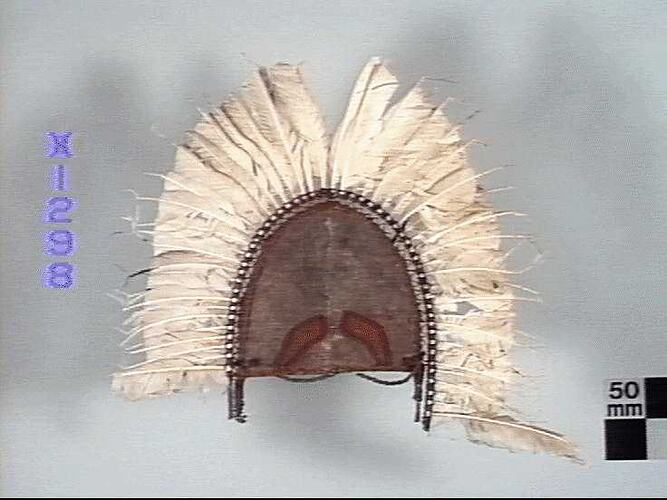Summary
This distinctive headdress is called a dhari by people in the eastern Islands of the Torres Strait, and dhoeri by those in the central islands. It is a classic form made and worn on the head for dance in the Torres Straits, and typically decorated with white feathers of a sea bird. Originally it would be made with a pearl shell or turtle shell in the centre. The introduction of Christianity had a profound influence on Torres Strait culture, and the performance of ritual was actively discouraged by the London Missionary Society who arrived at Erub (Darnley Island) in 1871. When Alfred Cort Haddon went to the Torres Straits in 1898 ritual performance was not commonplace. Today the making of the dhari or doeri has re-emerged as an iconic symbol for Torres Strait Islander people and is one of the motifs on the Torres Strait Island Flag.
Physical Description
An arched framework of sticks with clipped white feathers set into the outer edge. A semi-circular section of cloth or bark is stitched onto the frame and decorated with natural pigments.
Significance
This headdress very likely predates those collected by Alfred Cort Haddon in the University of Cambridge's Museum of Archaeology and Anthropology. While it was registered into the collection of the National Museum of Victoria (now Museum Victoria) in 1889, it is associated with Robert Brough Smyth, who offered his collection to the trustees for the Public Library, Museums and National Gallery in September 1877.
More Information
-
Object/Medium
Headdress
-
Maker
-
Locality
-
Date Produced
-
Collector
-
Date Collected
-
Object Measurements
595 mm (Length), 470 mm (Width), 40 mm (Height)
-
Keywords
-
Type of item
-
Discipline
-
Category
-
Collecting Areas
Australian Indigenous - Northern Australia and Queensland and Torres Strait Islands
